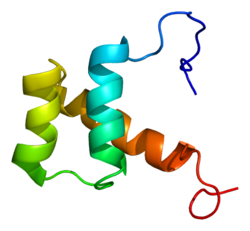Das Homöobox-Protein DLX-2 ist ein Transkriptionsfaktor, der beim Menschen durch das DLX2-Gen codiert wird.[1][2]
| DLX2 | ||
|---|---|---|

| ||
| Struktur des DLX2-Proteins | ||
| Masse/Länge Primärstruktur | 34 Kilodalton / 328 Aminosäuren (Isoform 1)
23 Kilodalton / 217 Aminosäuren (Isoform 2) | |
| Isoformen | 2 | |
| Bezeichner | ||
| Gen-Name(n) | DLX2 | |
| Externe IDs | ||
| Vorkommen | ||
| Homologie-Familie | Hovergen | |
Viele Wirbeltiergene mit Homöobox-Genen wurden auf Grund der Ähnlichkeit ihrer Sequenz zu Genen für die Entwicklung der Drosophila (Taufliegen) identifiziert. Mitglieder der Dlx-Genfamilie enthalten eine Homöobox, die mit der der „Distal-less“ (Dll) verwandt ist. Dll ist ein Gen, das im Kopf und in den Gliedmaßen einer sich entwickelnden Fruchtfliege vorkommt. Die „Distal-less“-Genfamilie (Dlx) umfasst mindestens sechs verschiedene Elemente, DLX1 – DLX6. Die DLX-Proteine haben eine Funktion im Vorderhirn und in der Entwicklung des Gesichtsschädels. Das Gen befindet sich in einer Konfiguration mit anderen Vertretern der Genfamilie auf dem langen Arm von Chromosom 2.[2]
Interaktion
BearbeitenDLX2 weist Protein-Protein-Interaktionen bei DLX5,[3] MSX1[3] und Msh homeobox 2.[3] auf.
Einzelnachweise
Bearbeiten- ↑ Ozcelik T, Porteus MH, Rubenstein JL, Francke U: DLX2 (TES1), a homeobox gene of the Distal-less family, assigned to conserved regions on human and mouse chromosomes 2. In: Genomics. 13. Jahrgang, Nr. 4, September 1992, S. 1157–61, doi:10.1016/0888-7543(92)90031-M, PMID 1354641.
- ↑ a b Entrez Gene: DLX2 distal-less homeobox 2. Abgerufen am 27. Oktober 2011.
- ↑ a b c H Zhang, Hu G, Wang H, Sciavolino P, Iler N, Shen M M, Abate-Shen C: Heterodimerization of Msx and Dlx homeoproteins results in functional antagonism. In: Mol. Cell. Biol. 17. Jahrgang, Nr. 5, Mai 1997, ISSN 0270-7306, S. 2920–32, PMID 9111364, PMC 232144 (freier Volltext).
Literatur
Bearbeiten- Harris SE, Guo D, Harris MA, et al.: Transcriptional regulation of BMP-2 activated genes in osteoblasts using gene expression microarray analysis: role of Dlx2 and Dlx5 transcription factors. In: Front. Biosci. 8. Jahrgang, 2003, S. s1249–65, doi:10.2741/1170, PMID 12957859.
- Qiu M, Bulfone A, Martinez S, et al.: Null mutation of Dlx-2 results in abnormal morphogenesis of proximal first and second branchial arch derivatives and abnormal differentiation in the forebrain. In: Genes Dev. 9. Jahrgang, Nr. 20, 1995, S. 2523–38, doi:10.1101/gad.9.20.2523, PMID 7590232.
- Selski DJ, Thomas NE, Coleman PD, Rogers KE: The human brain homeogene, DLX-2: cDNA sequence and alignment with the murine homologue. In: Gene. 132. Jahrgang, Nr. 2, 1993, S. 301–3, doi:10.1016/0378-1119(93)90212-L, PMID 7901126.
- Simeone A, Acampora D, Pannese M, et al.: Cloning and characterization of two members of the vertebrate Dlx gene family. In: Proc. Natl. Acad. Sci. U.S.A. 91. Jahrgang, Nr. 6, 1994, S. 2250–4, doi:10.1073/pnas.91.6.2250, PMID 7907794, PMC 43348 (freier Volltext).
- McGuinness T, Porteus MH, Smiga S, et al.: Sequence, organization, and transcription of the Dlx-1 and Dlx-2 locus. In: Genomics. 35. Jahrgang, Nr. 3, 1996, S. 473–85, doi:10.1006/geno.1996.0387, PMID 8812481.
- Zhang H, Hu G, Wang H, et al.: Heterodimerization of Msx and Dlx homeoproteins results in functional antagonism. In: Mol. Cell. Biol. 17. Jahrgang, Nr. 5, 1997, S. 2920–32, PMID 9111364, PMC 232144 (freier Volltext).
- Yu G, Zerucha T, Ekker M, Rubenstein JL: Evidence that GRIP, a PDZ-domain protein which is expressed in the embryonic forebrain, co-activates transcription with DLX homeodomain proteins. In: Brain Res. Dev. Brain Res. 130. Jahrgang, Nr. 2, 2002, S. 217–30, doi:10.1016/S0165-3806(01)00239-5, PMID 11675124.
- Strausberg RL, Feingold EA, Grouse LH, et al.: Generation and initial analysis of more than 15,000 full-length human and mouse cDNA sequences. In: Proc. Natl. Acad. Sci. U.S.A. 99. Jahrgang, Nr. 26, 2003, S. 16899–903, doi:10.1073/pnas.242603899, PMID 12477932, PMC 139241 (freier Volltext).
- Gerhard DS, Wagner L, Feingold EA, et al.: The status, quality, and expansion of the NIH full-length cDNA project: the Mammalian Gene Collection (MGC). In: Genome Res. 14. Jahrgang, 10B, 2004, S. 2121–7, doi:10.1101/gr.2596504, PMID 15489334, PMC 528928 (freier Volltext).
- Espinoza HM, Ganga M, Vadlamudi U, et al.: Protein kinase C phosphorylation modulates N- and C-terminal regulatory activities of the PITX2 homeodomain protein. In: Biochemistry. 44. Jahrgang, Nr. 10, 2005, S. 3942–54, doi:10.1021/bi048362x, PMID 15751970.